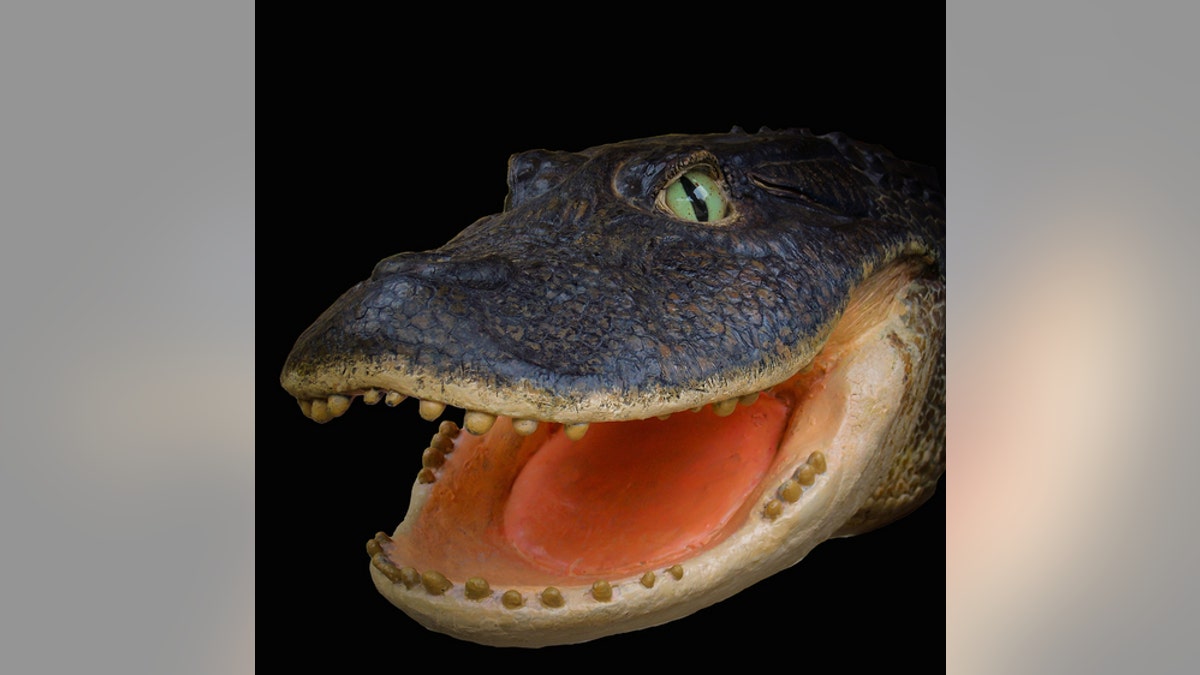
A model of the 13-million-year-old Gnatusuchus pebasensis, a crocodylian with a short face and rounded teeth that may have shoveled through the mud at the bottom of lakes and swamps to find prey, such as clams and other mollusks. (Model by Kevin Montalbán-Rivera.?© Aldo Benites-Palomino)
A peg-toothed crocodile relative with a mouth like a shovel lived in the prehistoric swamps of Peru about 13 million years ago, a new study finds.
The newly discovered reptile (Gnatusuchus pebasensis) is one of seven types of extinct crocodylians researchers found recently near the Amazon River in northeastern Peru. (A crocodylian is an order that includes crocodiles, alligators, caimans and gharials.)
Two of the crocodylians were already known to scientists, but the other five are newly discovered species, said the study's lead author, Rodolfo Salas-Gismondi, a graduate student at the University of Montpellier, in France, and chief of the paleontology department at the National University of San Marcos' Museum of Natural History in Lima, Peru. [See Photos of Crocodylian Fossils Found Along the Amazon River in Peru]
Salas-Gismondi and his colleagues spent more than a decade traveling to Peru to excavate the same bone bed on the banks of the Amazon River during the dry summer months. It's almost unprecedented to find seven ancient crocodile species living in the same sediment layer at the same location, he said.
"It's a single fossil community," Salas-Gismondi told Live Science. "All of these [crocodylians] were living at the same time and the same place."
Crushing clams
With their peglike teeth, the crocodylians may have been adept at crushing and crunching mollusks, such as clams and snails, Salas-Gismondi said. Modern-day crocs also eat mollusks, but shellfish are just a small part of their diet, he said.
It's possible the ancient crocodylians regularly dined on mollusks, as the bone bed has an abundance of damaged mollusk shells. In fact, 93 percent of the fossilized shells have "crushing predation scars," the researchers wrote in the study.
Now, the Amazon supports far fewer mollusks. Before the Amazon River formed 10.5 million years ago, the region contained an immense wetland with lakes, swamps, embayments and rivers. It drained northward into the Caribbean, unlike the Amazon River today, which flows eastward toward the Atlantic Ocean.
"As this [swampy] environment disappeared, the mollusks that were mainly adapted to this environment also disappeared," Salas-Gismondi said.
Perhaps the crocodylians evolved to have different eating habits as the clams died out and the environment changed from a swamp to a river, researchers said.
"When this diversity in mollusks decreases, you don't have as much crushing dentation in these caimans," said Sterling Nesbitt, an assistant professor of geosciences at the Virginia Polytechnic Institute and State University, who was not involved in the study.
Nowadays, many crocodylians have pointy teeth and long snouts that help them catch fish and other similar prey, instead of peglike teeth and rounded snouts that would make it easy to shovel through the mud and chomp on clams, Nesbitt said.
New crocodylians
At about 5 feet long, the shovel-mouthed G. pebasensis wasn't that big, but its might rested in its jaws. It had a short face with rounded teeth that "worked together as a crushing machine," Salas-Gismondi said. [Alligator Alley: Pictures of Monster Reptiles]
The Kuttanacaiman iquitosensis, another crocodylian species described in the new study, had a "robust, blunt and short snout," and closely packed rounded teeth, the researchers wrote in the study.
Another, Caiman wannlangstoni, had a "high and blunt snout" and also had tightly packed rounded teeth in the back of its mouth.
They also found a fossil belonging to a still-living genus of crocodylian, the smooth-fronted caiman Paleosuchus. This reptile has a longer and higher snout suited to catch a variety of prey, including fish and other swimming vertebrates, the researchers said.
Learning about the diversity of prehistoric crocodylians may help researchers get a better grasp on the reptiles' family tree, as well as Amazonian biodiversity, the researchers said. It’s difficult to find fossils in the Amazon River basin because the minerals needed to fossilize an organism often get recycled into the rainforest, and the high density of plants makes it challenging to dig there, Nesbitt said.
"Even though the Amazon is one of the best places in the world for biodiversity, understanding its history is very difficult because there aren't many fossils," Nesbitt said.
Today, the Amazon basin supports six species of caimans, but unlike their ancestors, only three live in the same area and they rarely share the same habitat, the researchers said.
The study is published in the Feb. 25 issue of the journal Proceedings of the Royal Society B.
- Image Gallery: Ancient Monsters of the Sea
- Alligators vs. Crocodiles: Photos Reveal Who's Who
- Wipe Out: History's Most Mysterious Extinctions
Copyright 2015 LiveScience, a Purch company. All rights reserved. This material may not be published, broadcast, rewritten or redistributed.




















